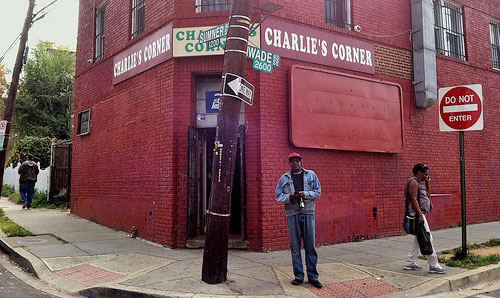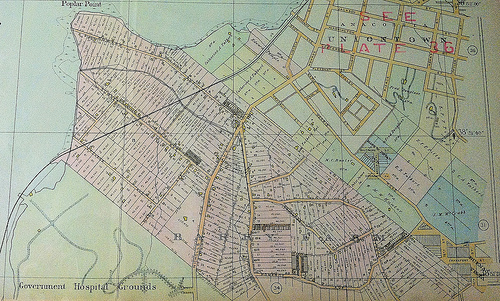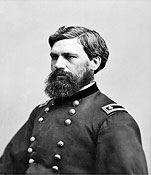Barry Farm street names reflect post-Civil War history
For denizens of the Barry Farm community in Southeast Washington, the 19th century still holds strong at the corner— Charlie’s Corner store. The neighborhood’s street names memorialize Union generals and Radical Republicans who advanced the rights of black Americans during the Civil War and Reconstruction.

Zabia Dews, the “Mayor of Barry Farm,” outside Charlie’s Corner store at the junction of Sumner and Wade Roads SE. Photo by the author.
“Look up at these street names,” says Zabia Dews, 63, of the 2700 block of Wade Road SE, pointing to signs above for the junction of Sumner Road SE and Wade Road SE. “There’s a history here people don’t know about, or they forgot. We can’t let it disappear.”
The original names remain today: Howard Road SE, which runs past the Anacostia Metro Station, for General Oliver Otis Howard; Sumner Road SE for Massachusetts Senator Charles Sumner; Wade Road SE for Ohio Senator Benjamin Wade; Pomeroy Road SE for Kansas Senator Samuel Pomeroy, an early member of Howard University’s Board of Trustees; and Stevens Road SE for Pennsylvania Congressman Thaddeus Stevens, prominently featured in Steven Spielberg’s “Lincoln.”
The James Barry farm
In 1801 the board of commissioners of the embryonic capital city wrote to the principal landholders “asking to be furnished with lists of lots sold by them.” Benjamin Stoddert, the first Secretary of the Navy, Notley Young, a prominent plantation owner, and more than a dozen other men including James Barry, “one of the incorporators of the Washington Canal Company,” received the letter.
"Mr. Barry was largely invested in business, both foreign and domestic, and he was very zealous as an advocate of the interests of the eastern section of the city, in opposition to the claims of the western section,” according to the Records of the Columbia Historical Society.
More than 60 years later, in April 1864, the surveyor of Washington County (all land in the District east of the Potomac, outside of the L’Enfant Plan and Georgetown) was “instructed to stone the new road between the northwest and southwest boundaries of the Barry Farm, known as the Stickfoot Branch road,” reported the Daily National Republican.
In September young men were drafted off the farm to fill President Lincoln’s call for a half million more Union troops. By now the Barry Farm, across the Eastern Branch from the Washington Navy Yard, was sandwiched between the United States Government Hospital for the Insane (Saint Elizabeths) which saw its first patient in 1855 and Uniontown (Anacostia), the city’s first subdivision.
At this time, during the Civil War, the city was brimming with “the floating colored population” of runaway slaves from “Maryland, Virginia, and farther South,” according to General Oliver Otis Howard’s autobiography. In 1865 Howard became Commissioner of the Freedmen’s Bureau, a government agency established to aid freed slaves and their families.
Riding through congested areas of Washington north of K Street, between 13th and 17th, Howard came upon a large group of freedmen.
“What would make you self-supporting?” asked Howard.
“Land! Give us land!” several replied.
In the spring of 1867, Howard used $52,000 in Freedmen’s Bureau funds to purchase all 375 acres of the Barry Farm. He sold 1- and 2-acre lots. Within 2 years, 266 families called Barry Farm home, including the sons of Frederick Douglass.
Old Barry Farm develops
“The land all the time was constantly inquired for by working freedmen,” Howard recalled. “It was taken with avidity, and the monthly payments, with very few exceptions, were promptly and regularly made. The prospect to the freedmen of owning a homestead was a great stimulus to exertion.” A schoolhouse for 150 pupils was quickly erected. Barry Farm was a self-sufficient, self-contained community.

An 1894 Hopkins map (plate 34) of Barry Farm shows streets names still in currency today. Photo from the DC Public Library, Washingtoniana Division.
Today, Barry Farm is almost exclusively associated with the faded 26-acre Barry Farm Dwellings, a 432-unit (nearly a third vacant) property of the DC Housing Authority. The name association hasn’t always been that way, says Dews, known as the “Mayor of Barry Farm” for his familial roots on Wade Road SE for nearly a century and his mentorship of neighborhood youth. “It’s been a long time since we’ve been a tribe. But that’s what we were and it’s important for the younger generation to know this history.”
As the city restarts its redevelopment planning process for Barry Farm Dwellings, at an estimated cost of $400 million over a timeline of two decades, the Barry Farm Resident Council, with assistance from Empower DC and local activists, has communicated to the DC Housing Authority that alongside issues of public safety, displacement and employment, a heritage preservation plan is a key concern. 140 years ago, Barry Farm residents and the city were similarly at odds.
According to the Baltimore Sun‘s Washington correspondent writing in the summer of 1872, “The board of public works propose to open streets in the village and as the residents there have each a deed of one acre of land for his cottage, they are not disposed to surrender any portion of their homesteads for streets or anything else without compensation.” When a contractor “appeared in the village to cut up the lots, he was beset, the horses taken from the street plows, the wagons upset, and the laborers driven away. In the afternoon the work was begun under the protection of the police.”
Then as now, self-preservation and kinfolk survival is the indigenous creed of Barry Farm, Dews says. “These street names are what’s left of the tribe that represented the hard work and sacrifice necessary to build families and businesses. We need to get back to the old way of living.”


